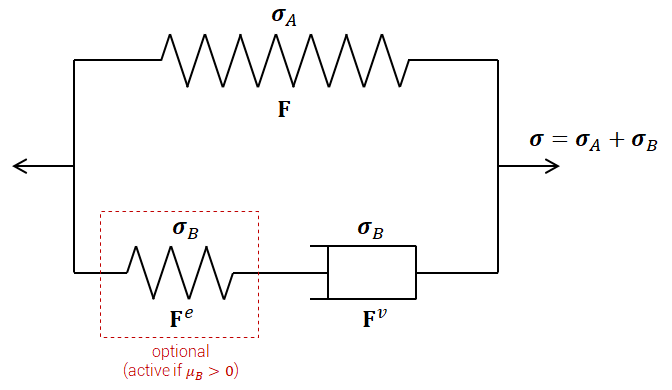MAT_BERGSTROM_BOYCE
FE
Material properties
Deprecated command
This command is deprecated and will soon be phased out.
"Optional title"
mid, $\rho$, $K$
$\mu$, $\lambda_L$, $a_0$, $a_1$, $\eta_\mathrm{max}$, $\dot{\gamma}_0$, $\xi$, $B$
$\sigma_0$, $Q$, $C$, $m$, $c_{dec}$, $\beta$, $W_c$, $\lambda_f$
$b_0$, $b_1$, $b_2$, $\mu_B$, erode
Parameter definition
Description
Model for polymers. It is based the Bergstrom-Boyce model, but has an optional different treatment of viscous effects.
The rheological model consists of two parallell networks, here referred to as Network A and Network B.

The total stress in the material $\mathbf \sigma$ is the sum of stresses in the two networks.
$\boldsymbol{\sigma} = \boldsymbol{\sigma}_A + \boldsymbol{\sigma}_B$
Network A is hyperelastic with damage and its stress is defined as
$\displaystyle{\boldsymbol{\sigma}_A = (1 - \eta) \cdot \frac{\mu}{J \bar\lambda} \cdot \frac{\mathcal{L}^{-1}\left( \bar\lambda / \lambda_L \right)} {\mathcal{L}^{-1}\left( 1 / \lambda_L \right)} \cdot \bar{\mathbf{C}}_{dev} + K \cdot \mathrm{ln}(J) \mathbf{I}}$
where $\mu$, $\lambda_L$ and $K$ (bulk modulus) are material parameters. $\mathcal{L}^{-1}$ is the inverse of the Langevin function, $J = \mathrm{det}\mathbf{F}$ and $\bar{\mathbf{C}}_{dev}$ is the deviatoric part of $\bar{\mathbf{C}}$:
$\displaystyle{\bar{\mathbf{C}} = J^{-2/3} \mathbf{F}^t \mathbf{F}}$
$\bar\lambda$ is a measure of the network stretch:
$\displaystyle{\bar\lambda = \sqrt{\frac{\mathrm{tr} \bar{\mathbf{C}}}{3}}}$
$\eta$ is the network damage and it evolves according to
$\displaystyle{\dot\eta = a_0 \cdot (\eta_{max} - \eta) \cdot \left( \frac{\bar\lambda}{\lambda_L} \right)^{a_1} \cdot \dot{\bar\lambda}}$
$\lambda_f$ is an optional failure stretch. The material will fail instantaneously if $\bar\lambda > \lambda_f$.
Network B is visco-elastic (if $\mu_B>0$) or purely viscous (if $\mu_B=0$). The stress in the elastic network is defined as:
$\displaystyle{\boldsymbol{\sigma}_B = \frac{\mu_B}{J^e \bar\lambda^e} \cdot \frac{\mathcal{L}^{-1}\left( \bar\lambda^e / \lambda_L \right)} {\mathcal{L}^{-1}\left( 1 / \lambda_L \right)} \cdot \bar{\mathbf{C}}^e_{dev}}$
where $J^e = \mathrm{det}\mathbf{F}^e$ and $\bar{\mathbf{C}}^e_{dev}$ is the deviatoric part of $\bar{\mathbf{C}}^e$:
$\displaystyle{\bar{\mathbf{C}}^e = (J^e)^{-2/3} (\mathbf{F}^e)^t \mathbf{F}^e}$
$\bar\lambda^e$ is a measure of the elastic network stretch:
$\displaystyle{\bar\lambda^e = \sqrt{\frac{\mathrm{tr} \bar{\mathbf{C}}^e}{3}}}$
Two different relationships between viscous stress and deviatoric strain rate are offered.
Alternative 1:
The effective viscous stress $\sigma_B^{eff}$ is defined from the relationship:
$\displaystyle{ \dot{\bar{\varepsilon}}^v_{dev} = \dot{\gamma}_0 ( \bar{\lambda}^v - 1 + \xi)^B \cdot \left( \frac{\sigma_B^{eff}}{\sigma_0 + Q\cdot(1 - \mathrm{exp}(-C \varepsilon^{eff})} \right)^m \cdot \frac{\boldsymbol{\sigma}_B}{\sqrt{\boldsymbol{\sigma}_B : \boldsymbol{\sigma}_B}} }$
where $\dot{\bar{\varepsilon}}^v_{dev}$ is a time averaged deviatoric strain rate:
$\displaystyle{ \dot{\bar{\varepsilon}}^v_{dev} = \frac{1}{c_{dec}} \int_0^t \dot{\varepsilon}^v_{dev} \cdot \mathrm{e}^{(\tau-t)/c_{dec}} \mathrm{d}\tau}$
and:
$\displaystyle{\bar\lambda^v = \sqrt{\frac{\mathrm{tr} \bar{\mathbf{C}}^v}{3}}}$
Alternative 2:
$\displaystyle{ \sigma_B^{eff} = b_0 (\bar{\lambda}^v - 1 + \xi)^{b_1} \cdot \left( \frac{ \dot{\bar{\varepsilon}}_{dev}^{eff}}{\dot{\gamma}_0} \right)^{b_2} }$
